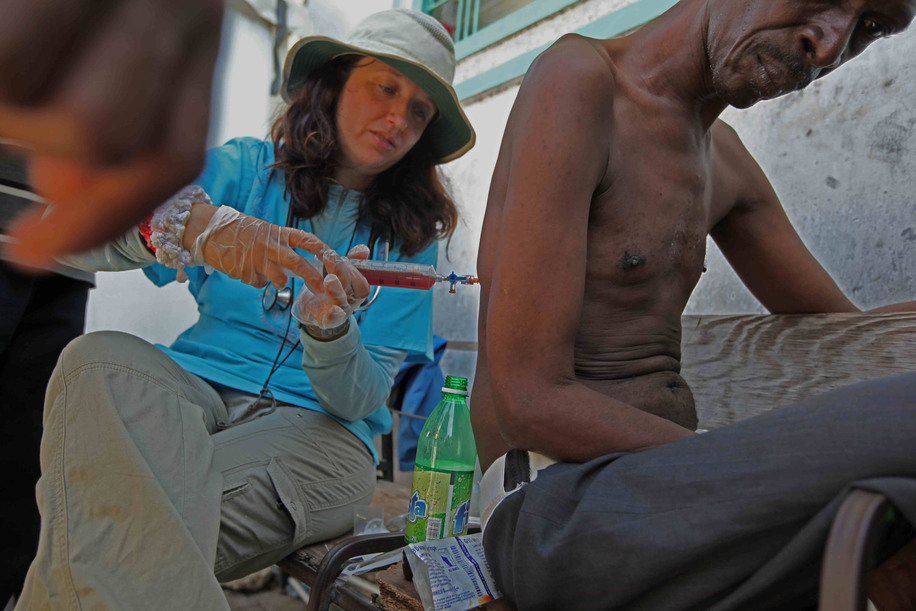

Dr. Coffee keeps up a constant batter as she inserts a needle into a TB infected lung, which has accumulated large pockets of fluid. She attaches a turkey- baster-sized, plastic syringe. The patients wince in pain. Some hold their nose. Coffee reassures them. Then she performs a thoracentesis (a procedure to remove fluid from the space between the lungs and the chest wall called the pleural space), withdraws the plunger on the syringe, closes off a valve, and empties the fluid into a soft drink bottle. She repeats the procedure, collecting 50 ml (1.5 fl oz) to 100 mL (3 fl oz) of fluid at a time, up to 1500 mL (50 fl oz) all together. Once the procedure is done, she removes the needle and bandages the site. Recovery is miraculous.
Miracle Worker: Saving Haitians from Tuberculosis
Richard Street | Port-au-Prince, Haiti
Organization: Streetshots
Photographer: Richard Street
Organization: Streetshots
Exhibit Title: Miracle Worker: Saving Haitians from Tuberculosis
Location: Port-au-Prince, Haiti
Working seven days a week, 12 hours a day, Dr. Megan Coffee directs a team of volunteer doctors and Haitian and American nurses who care for a vulnerable population in a country afflicted with the highest TB infection rate in the Western hemisphere. In two portable buildings and a tent surrounded by the ruins of Port-au-Prince, Coffee treats patients diagnosed with both HIV and TB. She -- and a constantly evolving staff of volunteer doctors and physicians -- save lives for pennies a day.
Tracy Kidder, Mountains Beyond Mountains: the Quest of Dr. Paul farmer, A Man Who Would Cure the World (Random House, 2003); Paul Farmer, The Uses of Haiti (Common Courage Press, 1994); Paul Farmer, Haiti After the Earthquake (Public Affairs, 2011); Peter Hallward, Damming the Flood: Haiti and the Politics of Containment (Verso, 2007); Amy Wilentz, The Rainy Season: Haiti- Then and Now (Simon and Schuster, 2011); Herbert Gold, The Best Nightmare on Earth: A Life in Haiti (Simon and Schuster, 1991); Bob Braun, “Maplewood doctor volunteers at Haiti’s largest hospital after devastating earthquake,” New Jersey Star-Ledger, July 20. 2010; Sanjay Gupta, “Deadly Cholera Spreading in Haiti,” CNN Transcripts, October 30, 2010; Jan Urbina, “Haiti Hospital’s Fight Against TB Falls to One Man,” New York Times, February 6, 2010.
Dr. Richard Steven Street is an academically-trained historian who photographs contemporary events in an effort to reach the widest possible audience. He tries to cut across the truncations of knowledge that artificially separate scholars from the general public. Street taught Liberation Photography in the James Weldon Johnson Institute for Advanced Interdisciplinary Studies, Emory University; he is presently at the Tanner Humanities Center, University of Utah. In fall 2014 he will become the Anschutz Distinguished Professor, Princeton University. He shot the essay with a protective mask. All patients or their relatives granted permission to be photographed. Dr. Street published this essay at socialdocumentary after all of the editors that he contacted at the the New York Times magazine replied to his query with "out of the office" messages.
Haiti Mission Project (www.haitimissionproject.org ); International Medical Corps (www.internationalmedicalcorps), Partners in Health (www.pih.org ); Operation Blessing International (www.ob.org ); Appropriate Infrastructure Development Group (www.aidg.org ).
Dr. Megan coffee’s Twitter account DokteCoffee and www.doctorcoffee.org
The following physicians, nurseses, and volunteers havew contributed to the success of the clinic:
Dr. Monica Gandhi [email protected]
(University of California, San Francisco for TB, HIV)
Jody Weschler [email protected]
(Clinic supplies)
Jeanne Vodicka and Ben Pritchard
(Clinic nurses)
Dr. Jen Halverson
(Clinic supplies and medical help)
UMCOR
(United Methodists)
Sister Mary Finnick
[email protected]
Graham Huff, David Holmes
(Website)
Alain Vallaincourt
(Logistics)
Grassroots United
(Housing, storage)
Neal Sidhwaney
(Computers) .
TB is eminently treatable and patients are almost always cured. It has all but disappeared from the rich nations but still plagues parts of the so-called Developing World to an extent that most Americans and Europeans would find astonishing. Today, TB kills around two million people, more adults than any other single infectious disease other than AIDS. It shares what Dr. Paul Farmer calls “a noxious synergy” with AIDS. An active case of AIDS often leads to a latent case of TB, and vice versa. In poor countries, TB is the most common proximate cause of death among people who died of AIDS. But because TB mainly infects the poor populations of developing nations, industrialized countries and pharmaceutical companies had for years lagged behind in their development of new technologies. There is no vaccine. Most TB drugs and diagnostic tools were developed a quarter-century ago.
TB vividly illustrates the massive gap between rich and poor. Improperly treated, or untreated, TB is a dreadful, deadly disease that eats away at lungs and often other organs of the body, including bones. About two billion people �" roughly one third of the world’s population �" have TB bacilli in their bodies. Most Haitians are infected with TB. Usually the disease remains latent. Only about 10 percent develop full blown TB. But the chance of becoming ill massively increases among poor people afflicted with malnutrition, malaria, and AIDS in a country where public health had massively deteriorated under years of military rule.
Tuberculosis spreads easily. It feeds on the lungs and spreads through sneezes and coughs. Those who live in crowded tent cities, in peasant huts and urban slums, in shantytowns and prisons and homeless shelters, all have a good chance of inhaling the bacilli and developing infections that expand into an active disease, and on occasion receiving inadequate treatment that transforms their TB into MDR (multiple drug resistant), a scary form of the disease. MDR TB first appeared in Haiti during the years of junta rule, when therapy was interrupted by strikes, floods, violence, and abrupt closing of therapy, and it became impossible to even get the required medicines into the country. TB kills more adult Haitians than any other disease
Make Comment/View Comments